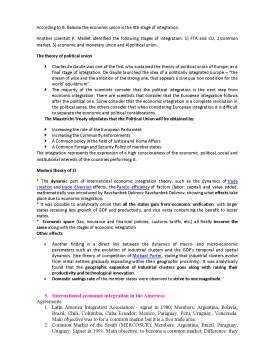Extras din notiță
1. The peculiarities of international economic integration.
- Economic integration is a term used to describe how different aspects between economies are integrated. The basics of this theory were written by the Hungarian economist Bela Belassa in the 1960s. As economic integration increases, the barriers of trade between markets diminishes. (The most integrated economy today, between independent nations, is the European Union).
- Economist Fritz Machlup traces the origin of the term 'economic integration' to a group of five economists writing in the 1940s, including Wilhelm Ropke, Ludwig von Mises and Friedrich von Hayek. Economic integration was the basis of US foreign policy after World War II.
When Marshall Plan was elaborated, the term economic integration was used frequently.
The word “integrate” comes from the Latin “integro, integration” meaning putting together, unifying parts into a single one. The term ”political integration” was used earlier than the economic one, in the 1920, having as synonym the “economic solidarity”.
In economics, the word integration was first employed in industrial organisation to refer to combinations of business firms through economic agreements, cartels, concerns, trusts, and mergers— horizontal integration referring to combinations of competitors, vertical integration - combinations of suppliers with customers.
In the current sense it is used as - combining separate economies into larger economic regions
- Transformation from micro-spaces to macro-spaces
- The lack of discrimination and the progressive elimination of discrimination in the economic relations between countries
- B. Balassa determined economic integration as a series of processes, through which different states form a commercial regional group or bloc.
The achievement of a complete unification between distinct economies. Emergence of the group of countries from the global economy by forming of a single economic structure.
- Positive (institutional) integration- implies at least a minimum of intervention for coordination and harmonization of economic policies for improving market’s structure
- and negative (functional) integration – it consists in eliminating all the barriers for free movement between states, or eliminating gradually of quantitative restrictions and import tariffs for trade among countries, in order to increase the economic growth of the integrated area.
We distinguish markets integration (short term) and integration of the economies (long term). Markets integration is a component part of the economies integration, that appears as a process launched by negative integration and regulated by positive integration.
Economic integration is analyzed as a process (taking the necessary measures to eliminate the discriminations) and as a state (it is considered the lack of any form of discrimination between economic entities).
2. Forms of economic integration. Preconditions and principles of economic integration
Forms of EI
1.Free Trade Area (FTA) - An area where tariffs and quotas are abolished for imports from area members, which, however, retain national tariffs and quotas against third countries
2. Customs Union (CU)- A FTA setting up common tariffs and quotas (if any) for trade with non-members (common trade policy)
3. Common Market (CM) - A CU abolishing non-tariff barriers to trade (product and services markets integration) as well as restrictions on factor movement (factor market integration, capital and labour) and also free movement of enterprises. The goal is that movement of capital, labour, goods, and services between the members is as easy as within them.
4. Economic Union (EcUn) - A CM with a significant degree of co-ordination of national economic policies and/or harmonisation of relevant domestic laws.
5. Total Economic Integration (TEI) Economic and Monetary Union - An EcUn with all relevant economic policies conducted at the supranational level, possibly in compliance with the principle of subsidiarity. To this aim, both supranational authorities and supranational laws need to be in place. Also is present a common currency. 6.* Full political integration
Preconditions:
1. Geographical proximity (important);
2. Steady economic growth;
3. Similar political systems (case in deep integration);
4. Supportive public opinion;
5. Cultural homogeneity;
6. Internal political stability;
7. Similar experience in historical and social developments;
8. Similar level of military preparedness and economic resources;
9. Bureaucratic conditions;
10. Previous cooperative efforts.
The main principals for international economic integration:
Successful integration has to be guided by principles which will assure that the sub regional and the national programs are compatible and mutually reinforcing. One such principle is open regionalism, it should be outward oriented; Market driver; Market forces rule; Private sector involvement. The other principle is subsidiary. And the other principle is gradualism.
Preview document
Conținut arhivă zip
- European Integration.doc

































